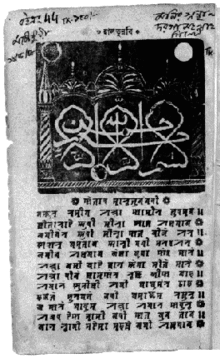Sadeq Ali
Muhammad Sadeq Ali Munsif | |
|---|---|
 Halat-un-Nabi by Sadeq Ali | |
| Native name | সাদেক আলী |
| Born | Shree Gour Kishore Sen 1798 or 1801 |
| Died | 1862 (aged 63–64) |
| Occupation | Munshi, judge, poet |
| Language | Dobhashi Bengali |
| Genre | Islam |
| Notable works |
|
Early life
Shree Gour Kishore Sen was born in a Bengali Baidya family around 1800.[4]
In August 1818, he was taught the basics of
He formally accepted
Career as a writer
ꠉꠚꠥꠞ ꠞꠢꠤꠝ ꠀꠟ꠆ꠟꠣ ꠇꠣꠖꠤꠞ ꠍꠥꠛꠢꠣꠘ
gôfur rôhim alla qadir subôhan
Glorified is the Oft-Forgiving, Most Merciful Allah, The Able
ꠍꠤꠔꠣꠞꠣꠄ ꠈꠥꠛꠤ ꠖꠤꠟꠣ ꠡꠣꠔ ꠀꠍꠝꠣꠘ
sitarae khubi dila shat asman
With stars, He beautified the seven heavens
ꠏꠝꠤꠘꠦꠞ ꠈꠥꠛꠤ ꠖꠤꠟꠣ ꠇꠔ ꠌꠤꠎꠦ ꠀꠞ
zôminer khubi dila kôtô chize ar
With many things, He beautified the earth
ꠡꠇꠟ ꠝꠢꠔꠣꠎ ꠈꠣꠟꠤ ꠉꠘꠤ ꠙꠞꠅꠀꠞ
shôkôl môhôtaj khali gôni pôroar
We are all needy except the All-Sufficient Provider
– First stanza - Munshi Sadeq Ali[4]
Sadeq Ali decided to take a reformist stance against the common Sylheti Muslim literature which had used
Sadeq Ali later composed another
Death and legacy
Long after Sadeq Ali's death in 1862,
See also
References
- OCLC 495614347.
- ^ a b c d’Hubert, Thibaut. "The khādim and the munshī: Śāh Garībullāh and Sādek Ālī". Foundational Maḥabbat-nāmas: Jāmī's Yūsuf u Zulaykhā in Bengal (ca. 16th–19th AD) (Thesis).
- ^ a b Bhuiya, Md. Abdul Musabbir (2000). Jalalabadi Nagri: A Unique Script & Literature of Sylheti Bangla. Badarpur, Assam: National Publishers.
- ^ a b "Puthi Halot-un-Nobi by Sadek Ali". Sylheti Translation and Research.
- ^ a b c Saleem, Mustafa (30 November 2018). মহব্বত নামা : ফার্সি থেকে বাংলা আখ্যান. Bhorer Kagoj (in Bengali).
- SBN 19-562203-0.
- S2CID 158262463.
- ^ "নাগরী লিপির গ্রন্থসম্ভার নিয়ে এল উত্স প্রকাশন" [Utsho Prokashon has come with a Nagri script book collection]. The Daily Ittefaq (in Bengali). 23 January 2014. Retrieved 7 February 2021.
- ^ "একুশের আবহ". Samakal (in Bengali). 23 January 2014. Retrieved 7 February 2021.
